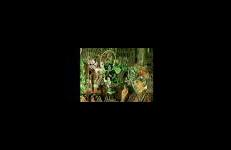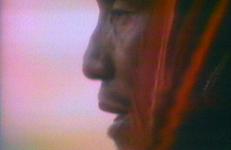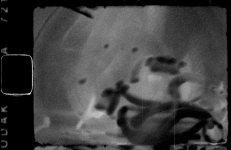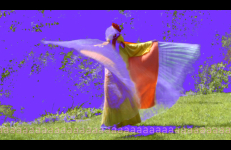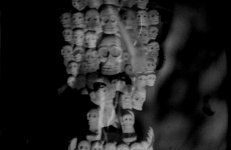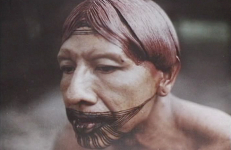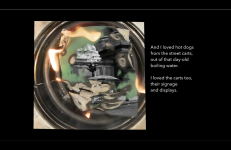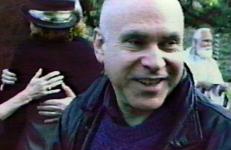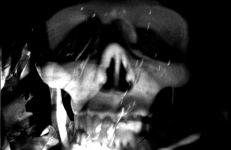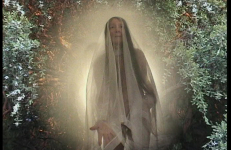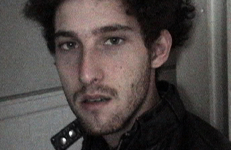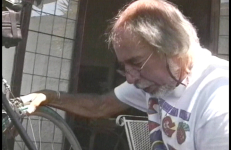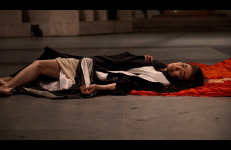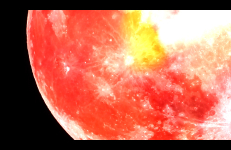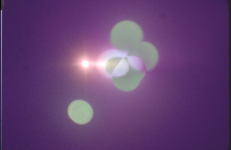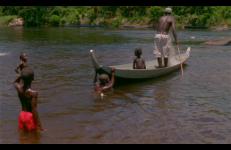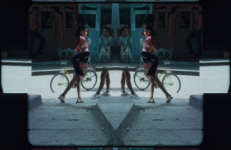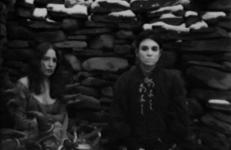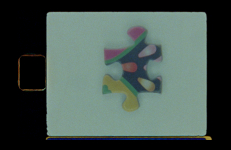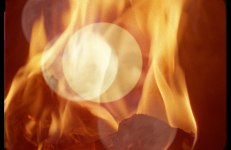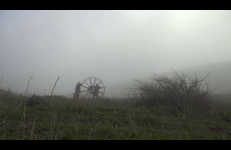The performance artist Stephen Varble spent the last five years of his life working on an epic, unfinished performance-turned-video titled Journey to the Sun (1978-1983). Only partially complete and under constant revision, this complex work combined Varble’s history of making costumes for performances with his fantastic stories involving metamorphosis and martyrdom. In 1982, Varble decided to make a “prelude” to Journey to the Sun, combining existing footage with new video taken in Riverside Park in New York City.
Ritual
The personal odyssey recorded in The Laughing Alligator combines methods of anthropological research with diaristic essay, mixing objective and subjective vision. Recorded while Downey and his family were living among the Yanomami people of Venezuela, this compelling series of anecdotes tracks his search for an indegenous cultural identity.
This video is related to Seven Years of Living Art (a seven-year performance of personal endurance Montano began in December of 1984) and adopts the Zen Chakra system of seven centers as a structuring device. The adoption of the Chakra system arises from Montano’s commitment to the study of Eastern culture and religion.
Lumbreras is the historical and archeological place of the bones, ruins and detritus. A window thought time, an ancestral rhythm of the audiovisual materials.
This video-lament for Mother Earth is a collaboration among Jim Barbaro, sound; Tobe Carey, cinematography and video editing; and Brenda Hutchinson playing a long tube.
"Made right after Covid lockdown, my art gave me an opportunity to rejoice, grieve and sonically face impermanence via sounds and a Chicken Dance I’ve been performing for decades. The beauty of this video is that it looks like Chicken Linda can finally FLY!! Please interact if you wish and dance, sing, cry, and FLY HIGH."
–– Linda Mary Montano
This is the invocation to the ancestral god of the underworld, the ancient annihilator, which preserves the ritual inertia of the bones and stones.
Using performance as a means of personal transformation and catharsis, Mitchell’s Death mourns the death of Montano’s ex-husband. Every detail of her story, from the telephone call announcing the tragedy, to visiting the body, is chanted by Montano as her face, pierced by acupuncture needles, slowly comes into focus then goes out again. The chanting is reminiscent of Buddhist texts, while the needles signify the pain that is necessary for healing and understanding.
Morayngava: the “design of things.” Yngiru: the box of the spirits, the films, just like xaman dreams. This is how the Asurini define video, which has just arrived in their village. After discovering that it is possible to store their images, the old men lament that they never stored images of their ancestors and decided to register the initiation of a xaman, a tradition threatened by new times.
Directed by Virginia Valadão and Regina Müller.
In Assurini with English subtitles.
Morayngava: the “design of things.” Yngiru: the box of the spirits, the films, just like xaman dreams. This is how the Asurini define video, which has just arrived in their village. After discovering that it is possible to store their images, the old men lament that they never stored images of their ancestors and decided to register the initiation of a xaman, a tradition threatened by new times.
Directed by Virginia Valadão and Regina Müller.
In Assurini with English subtitles.
... it's not what it used to be.
a personal album and homage, in my own way, to an influential film ... a closet-cleaning scrapbook of beloved photos and oddities ‐ and the gift of fire.
–– Ken Kobland
Kuchar makes it to the Isis Oasis resort just in time to catch the marriage vows of his friends Rebecca and Steve. Transposing the myth of Isis in their union, Kuchar tries to make sense of this recreated paradise, this gathering of God’s creatures, and the fates of Rebecca von Hettman and Charlie Sheen—in this humid, steamy, stained story of the transmigration of souls.
This surreal, free-form autobiography is concerned with childhood and adult rituals, and the longing for meaning and connection during the often wildly absurd events of early life. Obsessive Becoming returns to Reeves’s early exploration of personal narrative forms, poetry, and his interest in creating a more spontaneous and direct fusion between language and video. Words and images of the expectations and disappointments of coming of age break down the boundaries of both mediums.
This is the gaze that is reflected in the dark obsidian mirror.
‘ODDS AND ENDS’ is a dazzling patchwork of moods, lost and found, for the eye to savor.
It is in Pan’s playground where one hears lyrical words that echo in deep realms of imagination where one can dance with inspiration. But it is not all fun with fulfillment. The playground has vegetation with thorns that inflict the brain with a fever…
Ken Mate, a 56 year old solipsistic individual, recites Finnegan's Wake while doing sit-ups, talks about talking, and kvetches when a neighbor "steals" the first tomato from his hand-cultivated garden. Drawn from the inside out, this portrait describes who Ken is rather than describing what he does. Commissioned by and presented at the Second Annual Silver Lake Film Festival, 2001.
Eiko performed unannounced in the Cathedral of St. John Divine, New York City as an artist in residence in 2016-2018.
Camera by Alexis Moh.
This is the ritual consecration to the moon, on whose eroded surface the colorful blood of the fruits is poured, which is also our pulsating blood disseminated in the celestial body of the moon. Sparkling bleeding body that crosses the dark space of our present times. Part of the Lunar Films series.
Polished obsidian mirrors, tezcatl, were once used in ancient Mexico for divination, to traverse into the worlds of the gods and ancestors.
Through the obsidian mirror, the solar and lunar ritual used to be a celestial dance. In Ritual, suns and moons whirl around, glowing brighter as their paths cross.
“Animists are people who recognise that the world is full of persons, some of whom are human, and that life is always lived in relationship with others.”
-- Graham Harvey, Animism
Trance dance and water implosion, a kino-line drawn between secular freak-outs and religious phenomena. Filmed in a single take at a sacred site on the Upper Suriname River, the minor secrets of a Saramaccan animist's everyday are revealed as time itself is undone. Rites are the new Trypps -- embodiment is our eternal everything.
Sensemayá is a shamanic composition, an ecstatic dance, and ritualistic spell which distills and exudes the kinetic motion of the ancient snake that inhabits our present dislocated times. Shifting from the poetic to the unsettling and the foreboding, Sensemayá contorts and repeats its patterns, pulsating images that feel out of time, encompassing the past, the present and the future.
A Japanese Kabuki-influenced performance piece, shot in the woods in Winter. A masked woman emerges from a snowy forest and approaches a stone dwelling, where another woman is waiting. The pair enact a tea ceremony in silence.
In the next scene the tea tray appears in the road, and then disappears after a car passes. Image processing magic.
Please note, production year is approximate.
In the center of the rising Temple, the history, myth, ancestral and infrareal combine their rhythms into the cycle life of ritual cinema. Trance and shamanic visions arise into the ancient Teocalli.
Tlecáxitl is the sacred furnace where the new fire begins. This is the place where the sun, the moon and fire coincide in their cosmic dance to unleash vital irradiation. Part of Tonalli.
Tochka depicts a journey made by anonymous group through a rough landscape. After many hardships, they arrive at a shallow ravine where they decide to build a rickety wooden bridge so that they can cross to the other side. Utilizing low-tech handmade machinery and a cumbersome logic, the film questions collective ideology and the process of making art as a community.




